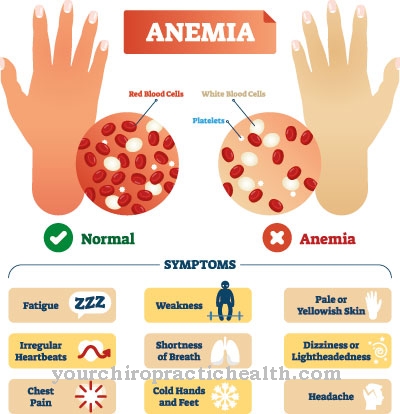At a Thrombocytosis the platelets in the human blood are temporarily and temporarily increased significantly. For example, thrombocytosis occurs in response to blood loss or inflammation. The treatment takes place depending on the cause in each individual case and can include the administration of ASA, for example.
What is thrombocytosis?

© Balint Radu - stock.adobe.com
The platelets in human blood are also known as thrombocytes. Platelets arise from the constriction of megakaryocytes in the bone marrow and have a specified lifespan of between five and twelve days. Old platelets are broken down within the spleen, liver and lungs. Platelets are endowed with glycolysis enzymes.
They contain elements of the pentose phosphate cycle, the respiratory chain and the citric acid cycle. In addition, platelets can release the so-called arachidonic acid from their cell membrane. In the circulating blood there are only inactive platelets that are activated by surface contact. Activated thrombocytes release substances to stop the bleeding and, through adhesion and aggregation, close an injury.
As Thrombocytosis a temporary increase in the number of platelets in human blood is known. The number of blood elements increases in thrombocytosis over 500,000 / µl. Thrombocythemia, in which the blood platelets multiply in the long term, must be distinguished from thrombocytosis. By contrast, thrombocytosis is a reversible, time-limited increase.
causes
The causes of thrombocytosis can be of various types. For example, a short-term increase in the number of platelets can correspond to a reactive change in the blood count, as occurs in the context of diseases of the hematopoietic system, after splenectomies, or after major blood losses. For this reason, for example, patients are often affected by the phenomenon after operations.
However, the number of platelets in the blood can also temporarily increase as a result of infections or tumor diseases. Cytostatic chemotherapy, chronic iron deficiency and chronic inflammatory diseases can also result in temporary thrombocytosis.
Thrombocytosis in the context of myeloproliferative diseases must be differentiated from these causes. In these diseases there is an increased proliferation of the cells. We are talking about primary thrombocytosis or essential thrombocythemia, which results in a strong increase in platelets in the blood. In the case of causes such as severe blood loss, opinions differ on the question of how to deal with it.
Symptoms, ailments & signs
Patients with thrombocytosis have increased levels of platelets in the blood. The platelet count physiologically makes up a certain volume fraction of the blood. Typical values are ten to the power of three / µl and ten to the power of nine / l. In patients with thrombocytosis, the values are above 500,000 / µl. An important feature of thrombocytosis is that it is only a temporary and usually short-term increase in blood platelets.
This increase is itself a symptom and cannot be classified as a disease in the narrower sense. An extremely high number of blood platelets can, depending on the cause, promote thrombosis. The symptoms that accompany thrombocytosis depend on the primary cause. For example, if there has been a lot of blood loss, it can result in shock or even hemorrhagic fever. In such situations, thrombocytosis is a natural reaction of the body with values of up to 1,000,000 per µl.
Diagnosis & course of disease
The diagnosis of thrombocytosis is made by laboratory diagnosis. In this context, a number of 500,000 platelets per centiliter of blood is used as a guideline for diagnosis. The increase in blood platelets is usually attributed to a specific cause within the diagnosis.
The cause can be clear after operations or accidents and then does not require any further clarification. In less clear-cut cases, a more detailed explanation of the cause must be carried out, which may require extensive clinical investigations. The patient's prognosis depends on the cause of the increase.
Complications
Thrombocytosis does not always have to lead to serious symptoms or severe complications. If the symptom occurs only briefly, it usually does not need to be treated and there are no further symptoms. However, the thrombocytosis can also lead to a severe fever and must be treated in this case.
In the case of long-term complaints, a causal treatment of this disease is also necessary in order to avoid further complaints and complications. This complaint can arise especially after an accident or after an operation and must be examined and treated. Since blood loss is usually stopped quickly after an accident, the symptoms of thrombocytosis will go away on their own.
Treatment of thrombocytosis can be done with the help of drugs and usually takes place without complications. With the help of blood thinning agents, the symptoms can be relieved and limited relatively well. There are no further complications. The life expectancy of the patient is also not restricted by the disease. In the case of internal bleeding, however, further surgical interventions are necessary to stop it.
When should you go to the doctor?
In the case of thrombocytosis, the person concerned is in any case dependent on treatment by a doctor. This disease cannot heal itself, so a visit to a doctor is essential. If there is no treatment, the symptoms usually continue to worsen and there are significant complications.
In most cases, thrombocytosis will be determined by a blood test. A doctor should be consulted if the blood value exceeds the corresponding maximum value and should therefore be checked. However, this excess gradient can only occur for a short time, so that a new test should usually be carried out to confirm the suspicion. The thrombocytosis can be detected by a general practitioner. A high fever can also indicate thrombocytosis and should then be examined by a doctor if it lasts for a long time and does not go away on its own.
Thrombocytosis is treated by a general practitioner or an internist. The treatment itself depends on the exact cause of the disease.
Treatment & Therapy
Thombocytosis is usually treated causally. This means that the primary cause of the rise in platelets is defined and, if possible, eliminated. If the cause cannot be eliminated, drug solutions are available to reduce the platelet count. However, in connection with certain causes, there is a controversial discussion about whether such an intervention is even useful.
Especially after major blood losses, many scientists consider the naturally reactive overproduction of platelets to be a phenomenon that does not require medical intervention. Other scientists consider drug intervention to be necessary in these cases too and fear thrombosis as a possible complication of the increased platelet count despite the blood loss.
In the case of drug intervention, ASA is usually administered to the patient. It is acetylsalicylic acid, which is a widely used pain reliever, anti-inflammatory and anti-fever drug. In addition, ASA can become active as a platelet aggregation-inhibiting agent. ASA lowers the risk of thrombosis by having a blood-thinning effect.
However, the administration is counterproductive in the case of internal bleeding, for example, since a thinning of the blood in this context could contribute to the patient bleeding to death. Therefore, in most cases, the active ingredient is not administered after accidents. In the case of thrombocytoses of any other cause, treatment with AAS is one of the most common therapeutic steps.
You can find your medication here
➔ Drugs for wound treatment and injuriesprevention
Thrombocytosis can have many causes. They can only be prevented to the extent that their causes can be prevented. Thus, for example, all preventive steps in relation to high blood loss and inflammatory phenomena count as preventive measures. Since chronic iron deficiency also increases the number of blood platelets, sufficient iron intake is also a preventive measure.
Aftercare
In the case of thrombocytosis, there are usually only a few and usually only limited follow-up measures available. The person affected should therefore consult a doctor at the first symptoms of this disease so that there are no complications or other complaints in the further course. An early diagnosis with subsequent treatment usually has a very positive effect on the further course of the disease.
In most cases, the thrombocytosis leads to various malformations in the child, so that it is dependent on intensive care in its everyday life. As a rule, thrombocytosis cannot be treated during pregnancy, so that the various malformations and malformations can only be corrected after the child is born.
Most of those affected are usually dependent on a surgical procedure, which can alleviate the symptoms. The earlier this procedure takes place, the better the further course is usually. After such an operation, it is important to refrain from exertion or from stressful and physical activities. Usually this disease does not reduce the life expectancy of the person affected.
You can do that yourself
Thrombocytosis usually does not need treatment. Usually the number of platelets in the blood is only slightly increased and there are no symptoms whatsoever. Treatment is needed if the platelet count is excessively high, as it can disrupt blood circulation. The cause of the thrombocytosis must also be clarified. The patient can contribute to this by informing the doctor about previous illnesses and risk factors.
If the symptoms occur after acute bleeding or an operation, the doctor must be consulted. Self-treatment is also not recommended for severe infections. It is important to fix the trigger before treating the symptoms over the long term. Patients suffering from rheumatic diseases or chronic inflammatory bowel disease should consult their doctor. Self-treatment does not make sense in this case either.
In addition, various general measures are useful. Because the platelet imbalance can lead to fatigue, rest and rest. The patient should go to sleep if they have a headache or dizziness. Cooling pads can help with severe nosebleeds. Night sweats can best be remedied by an optimally air-conditioned bedroom. Exercise and massages help with calf cramps. Bleeding gums and vision problems should be treated by a doctor.

.jpg)


.jpg)






















